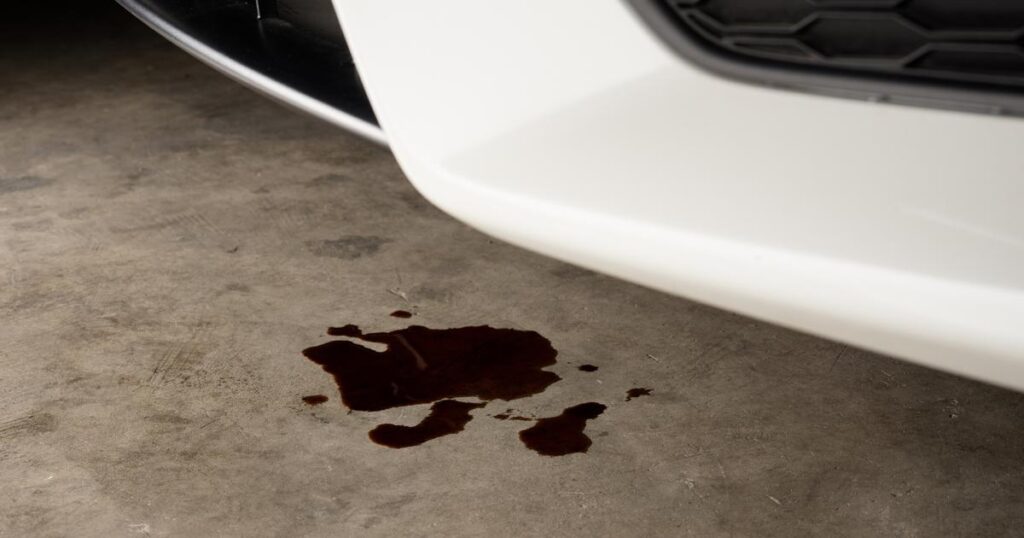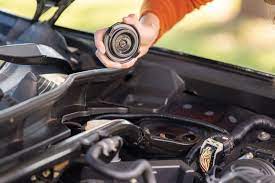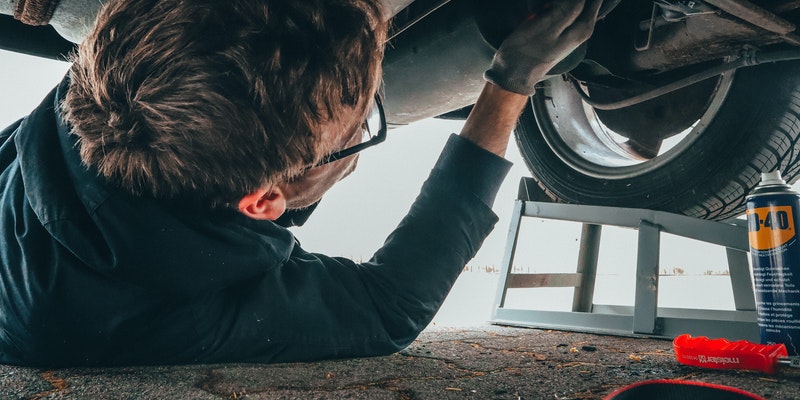You’ve probably come across a mysterious leak under your car as a car owner at some point in your life. And you wouldn’t be the only one if you were having trouble coming up with an explanation. But what exactly are these leaks? You should first try to stop the leaks. Put down a piece of butcher paper, newspaper, cardboard, or aluminum foil underneath your car to catch the leaks since it will be difficult to see them clearly on the dark pavement. We’ll go over the car’s fluid leak in more detail in this article. Please keep reading.
Identify Where The Leak Is Coming From
Your leak’s source will serve as the first identifier. A leak coming from the rear of your car is most likely differential fluid if it is a rear-wheel drive vehicle, which is common for pickup trucks, some sports cars, and most vintage cars. The gas tank may also be to blame for a leak in the back.
There are a few fluids that might leak from the engine compartment. One of these is brake fluid, which can occasionally leak near the rear of the engine compartment, where the brake master cylinder is located, or along the brake lines. Coolant and power steering fluid leaks typically originate from the front of the engine bay.
Although oil leaks can occur from anywhere in the engine bay, they typically originate from the oil pan at the base of the engine. Depending on the car model, the windshield fluid tank may be located in a different place in the engine bay, where it tends to leak windshield wiper fluid.
Since the transmission is typically placed behind the engine, a leak at the rear of the engine bay or just to its rear could be transmission fluid. Water that leaks from the air-conditioning evaporator will also collect in the car’s center.
Car Fluids: Colors And Meanings
- Red – Red leaks on your car typically indicate that the power steering system or transmission is leaking. Transmission seal problems or a hole in the return line, which carries fluid from one system to another, are among the causes of leaking transmissions.
- Yellow – Coolant from the radiator is usually to blame if your car is dripping yellow fluid. A damaged o-ring or a loose hose clamp could be the cause of the problem. The recommended coolant is specified by the manufacturer of your car. Leaks are more likely to occur if the incorrect coolant is used.
- Green – Your vehicle may be leaking antifreeze if it has green fluid leaks. This frequently results in leaks from the car’s water pump, radiator, or hoses due to the use of the wrong antifreeze or improperly attached components.
- Orange – There are several possibilities when the fluid that is leaking is orange. If the condensation on your radiator is turning orange, your radiator may be rusting or leaking antifreeze. Old transmission fluid may also have an orange appearance.
- Blue – Wiper fluid is most likely the source of any blue leaks. Fluid leaks may occur due to the deterioration of the reservoir and tubing that occurs over time.
- Clear – You probably don’t need to be concerned if your car leaks clear fluid. Condensation is the most common type of clear liquid that leaks from your air conditioner. It doesn’t hurt to have your car inspected if you’re still unsure.
- Pink – Pink fluid is typically the result of a transmission fluid leak or a leak in the power steering fluid. Usually, a worn seal in the return line is the reason for this kind of leak.
- Brown – Brown fluid could indicate either of two things, depending on the shade. Oil or fuel lubricant leaks can cause light brown fluid to appear. If your car is leaking brake fluid or old motor oil, the substance will be dark brown.
Six Most Common Fluids To Leak From A Car
The six fluids that most commonly drip from a car are:

Water Leaking From Your Car
The three H’s—hazy, hot, and humid—are probably the most typical reason for fluid leakage from a car in the eastern United States. at least. The moisture that an automobile’s air conditioner removes from the air inside the passenger compartment needs to be dealt with in some way. A rubber hose is used to drain the water onto the ground underneath the car.
Until the cabin humidity is almost completely gone, water will pour out of the air conditioner drain and onto the ground on extremely humid days. When I said earlier that some leaks are expected to occur, I meant this.
This hose is typically located in the middle of the cabin or to the front right, close to where the passenger rests their feet. A more recent minivan or large SUV with front and rear climate control may be equipped with two evaporators and two air conditioner drains, one in the front and one in the back.
Here’s a Tip: When you use the air conditioning system, it’s best to keep the recirculation button in the “on” position rather than the “fresh air” position. If you leave the car in “fresh air” mode, it will continue to drag humid air into the car, the vehicle’s cabin will never reach optimum temperature, and sometimes when the weather is extremely humid, the air will turn into the fog as it pours from your vents into your car’s passenger cabin.
Oil Leaks
Engine oil, or “motor oil,” may vary in color from light amber to dark brown, depending on how well you maintain your car. However, it’s not always immediately clear where your engine is located. Common sense tells you that if there is an oil leak, it will be under the engine.
Don’t laugh: Depending on where the transmission is mounted, the engine in a front-wheel-drive vehicle may be located in the front left or front right of the vehicle, or it may be in the rear if you drive a Porsche or a VW bug.
The only thing left to do is locate the leak once you realize that the engine is dripping oil. If you are unable to identify the precise source of the leak, you may want to have a mechanic examine it. Oil leaks can originate from relatively hard-to-find places like a crankshaft seal under the timing cover or from obvious places like a valve cover gasket.
Check your dipstick often if you know you have an engine oil leak. Drive only when the oil in your car is full. Overheating will cause it to malfunction. Avoid driving your car at all if it has a significant oil leak.
Coolant Or Antifreeze Leaks
Previously green, coolant is now available in a variety of colors, depending on whether the coolant is made by a specific car manufacturer or not. I’ve seen orange, green, and every color of the rainbow, while Honda offers blue coolant, Mercedes uses clear, and Toyota uses red.
Coolant tastes sweet and has a sweet, candy-like aroma. It is poisonous and should not be tasted; however, I have inadvertently tasted it a few times throughout my career.
Because your engine is covered in coolant hoses, a coolant leak could be almost anywhere. Some coolant hoses—the heater hoses—enter the passenger area itself. Your radiator, which is situated behind the grill at the very front of your car, is where coolant leaks happen most frequently, though.
There’s a chance you can smell a coolant leak if you think you have one. Take a quick glance at the coolant overflow tank; it is usually see-through and has “high” and “low” markings on it.
Let your engine completely cool before checking the radiator if it’s empty or if you’re unsure of what you’re seeing. On a warm engine, avoid removing the radiator cap. Your face could get severely burned if hot coolant or steam is blown at you. You might have a leak if, when looking down into the radiator, you can’t see any coolant.
Driving a vehicle with significant coolant loss is not advisable. It may become too hot and damage the engine. Keep a close watch on the thermometer. Alternatively, it may be towed to a repair location.
Transmission Fluid Leaks
Red or pink fluid is used extensively in automatic transmissions. The car will frequently begin to rev without shifting into gear as the first sign of an automatic transmission leak. If the leak persists, eventually the car won’t move at all.
Specially formulated fluids by the manufacturer are used in automatic transmissions. I advise adhering to Honda’s instructions and using their suggested fluids because failing to use automatic transmission fluid (ATF) made by Honda will degrade shift quality and void your warranty.
Standard (“manual”) transmissions use gear oil (like heavy, strong-smelling motor oil; see “Gear Oil” below) or the manufacturer’s proprietary manual transmission fluid. The transmissions in very old Hondas are equipped with regular motor oil.
A front-wheel-drive car’s axle seals and a rear-wheel-drive car’s output shaft seal are the two locations where transmission fluid leaks occur most frequently. Check the level of your transmission fluid by removing the transmission dipstick if you notice red or pink fluid underneath your car.
The proper way to check the transmission fluids should be found in the owner’s manual because different manufacturers have different procedures. Some manufacturers even forbid you from checking the fluid, as in the strange case of the Honda Passport’s last model, which had no way to do so!
Gear Oil Or Differential Fluid Leaks
Whatever name you give it, differential fluid is extremely thick, looks like honey, and smells like a warm, greasy Mack truck parked at a truck stop. Other names for it include hypoid, gear oil, gear fluid, and gear fluid. The smell of this substance lingers on your hands for days.

When it’s fresh and clean, gear oil is dark brown or dark amber. This fluid will be dripping if your rear differential or standard transmission is leaking. Wheel bearing seals or rear axle seals may also leak gear oil.
You may occasionally notice oil being thrown out of the wheel’s center and onto the car’s rim. The wheel’s surface will become black with accumulated dust. Gear oil leaks can also occur from the front axle of a four-wheel-drive vehicle. You can tell if it’s gear oil or not just by the smell.
Power-steering Fluid Leaks
Because some manufacturers use transmission fluid and some use their own brand of power steering fluid, it can be difficult to describe power steering fluid specifically. Honda uses a light amber-colored proprietary power steering fluid. Power steering fluid may smell distinctive, somewhat like burnt cooking oil.
The reservoir should be your first port of call if you believe you might have a power steering fluid leak. It should be simple to determine whether the fluid level is low because the reservoir will have high and low markings.
The power steering pump will whine when attempting to turn the wheel, and the steering wheel will feel tight when turning in a parking lot or at slow speeds, among other symptoms of low fluid. On each end of the steering rack is where power steering leaks occur the most frequently. Both sides of the steering rack have end seals, and because they experience the most wear and tear, they are the first to start leaking.
What Should You Do?
What the leak is will determine what you should do next.
Brake Fluid Leak
It is unsafe to drive a car that is leaking gasoline or brake fluid. Tow it to a shop or attempt to resolve the issue on your own. You might need to change the brake cylinders or brake lines if your brake fluid is leaking. Watching our how-to videos can help you if you need to replace the brake lines because they provide useful advice on how to bend and flare brake lines correctly.
Gasoline Leak
Although the fuel pump or fuel lines are other potential sources, a leak in the gas tank is most likely to be the source. Visit our how-to video library to search for a how-to video specific to your year, make, and model.
Power Steering Fluid Leak
A power steering fluid leak should also be fixed right away. That might entail changing your steering rack or power steering pump. By reading our article and watching our instructional videos, you can learn how the power steering system functions and why it’s crucial to fix leaks.
Coolant Leak
Overheating brought on by a coolant leak could cause further damage to the vehicle or leave it stranded on the side of the road. Nevertheless, the size of the leak has a significant impact on how serious the coolant leak is.
Make sure your coolant level isn’t dropping too quickly even if you think you can drive with a small leak. It’s important to identify which component of the cooling system is leaking (how-to videos are available for the radiator, water pump, and radiator hoses, which are all common leak points).
Transmission Fluid Leak
Maintaining a sufficient level of differential fluid or transmission fluid is crucial because low levels can cause the gears inside those components to wear out. Wear to the differential cover, which can be easily changed, is the most likely reason for a differential fluid leak.
Your transmission fluid pan may need to be changed if you notice a leak in your transmission fluid, and doing so is not particularly difficult.
Water Leaking
As we hinted at earlier, your air conditioner’s evaporator may occasionally leak water. The biggest puddles can occasionally result from this, but it doesn’t cause any issues at all. The cold refrigerant in the A/C system causes water to condense on the outside of the A/C evaporator, where it drips into the housing for the evaporator.
Through a bottom valve, the housing occasionally releases a lot of that water all at once. It creates a sizable puddle, which may be unsettling, but it doesn’t mean anything is wrong with your car. Therefore, if you have a watery, clear, odorless leak and you’re running your air conditioner on a hot, humid day, it might just be water and nothing to worry about.



